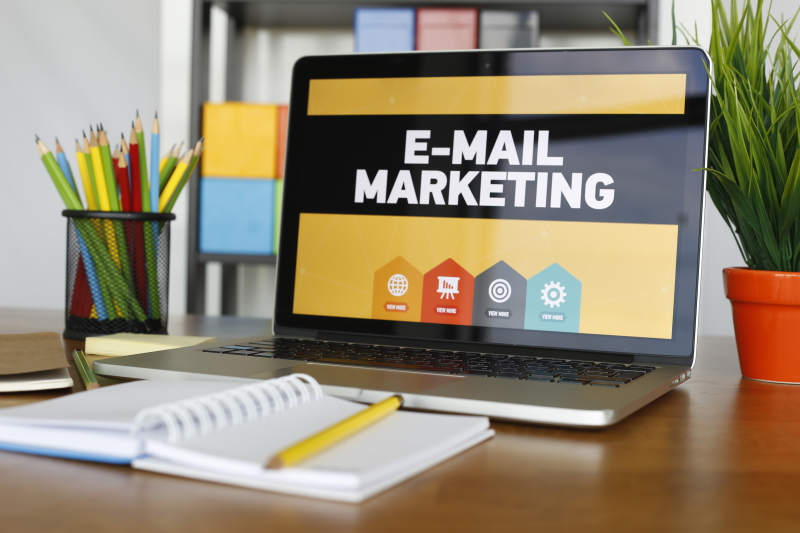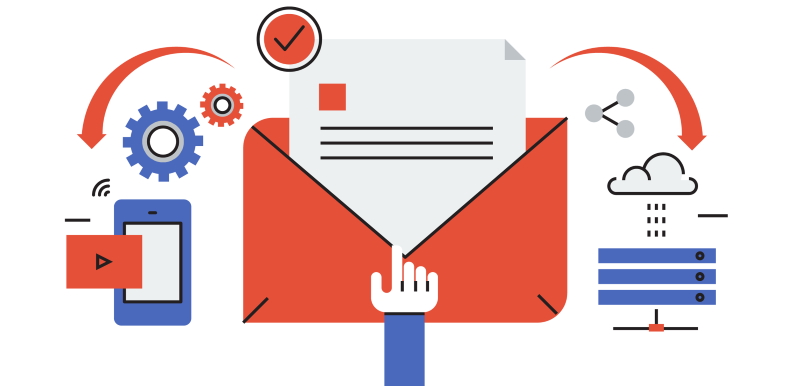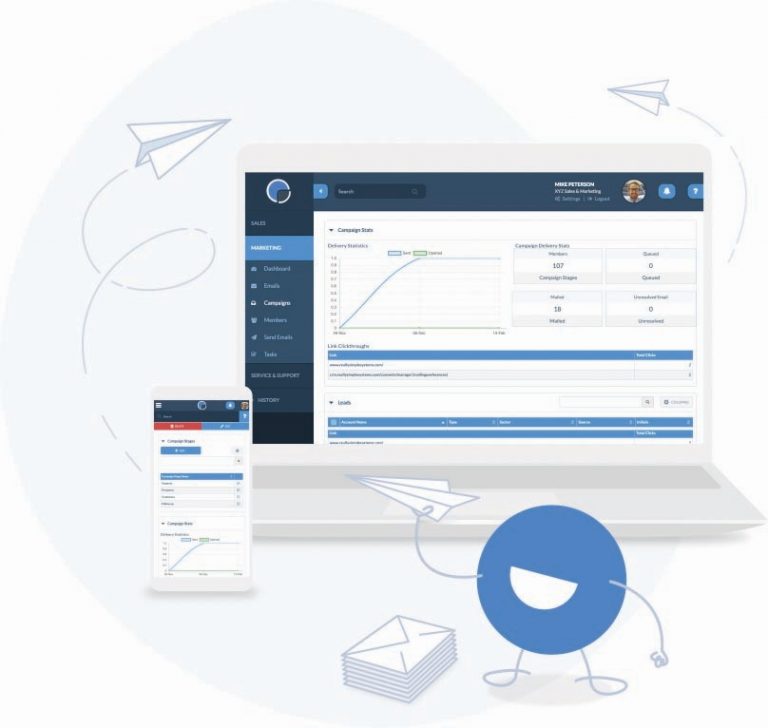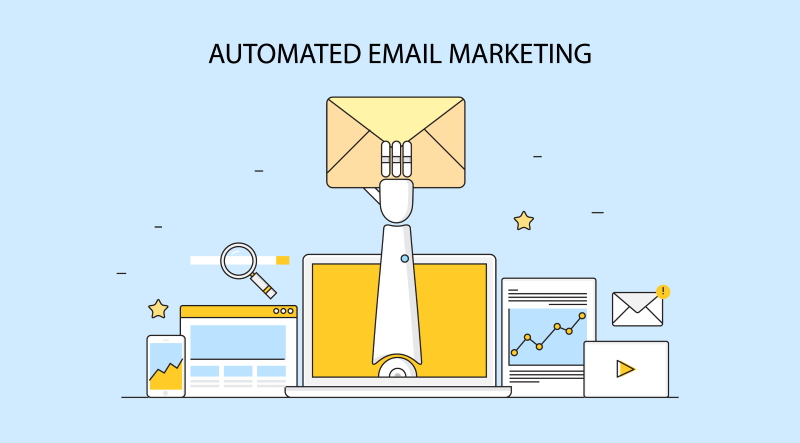The Ultimate Email Marketing for Small Business Guide
Lay the foundations for successful email marketing campaigns and strategies with our ultimate small business guide.
How to Get Started with Email Marketing
Email marketing continues to be one of the most effective ways of driving traffic to your website which can have a positive impact on your bottom line. With the right approach, you can use it to both increase your sales and build lasting relationships with your customers.
What could be easier, you’re just sending an email to your database, right? Wrong! We all know what it is like to have our inboxes flooded with marketing emails that are of no interest to us. Ultimately, with these kinds of emails, we either delete them, don’t read them, unsubscribe from them or simply flag them as spam. Here is where the problems begin. Unsolicited emails can cost your business by damaging your reputation and you could even be fined or blacklisted.
Building an effective email marketing campaign is all about doing the right things in the right way, at the right time and aimed at the right people.
What are the Benefits of Email Marketing?
Email marketing continues to be the primary driver of customer retention and acquisition for small and medium-sized businesses. In fact, 81% of SMBs still rely on email as their main customer acquisition.
In 2019 alone, 293.6 billion emails were sent and received each day. That is already a staggering number, but this figure is expected to increase to over 347.3 billion daily emails by 2022 despite the emergence of new forms of communication. Proving that email marketing isn’t going anywhere soon.
There’s no surprise that with the widespread popularity and indisputable benefits of email marketing, the return on investment (ROI) is massive. In other words, a well-thought-out email marketing strategy will make you money.
For every $1 you spend on emails marketing, you can expect an average ROI of $42.
In fact, email is so popular among marketers that email engagement is the top metric to evaluate content performance. Nine out of ten marketers say they regularly look at email metrics such as open rates, click rates, and downloads to determine how successful a piece of content is, more so than website traffic and social media analytics.
Bearing these email marketing statistics in mind, it’s hard to ignore the potential of a great email marketing campaign.
What Can You Use Email Marketing For?
There are many reasons to use email marketing tactics — some of the most common including:
Building relationships.
Boosting brand awareness.
Promoting your content.
Generating leads.
Marketing your products.
Nurturing leads.
Create an Email Marketing Strategy
Before you get overwhelmed with the vast possibilities within email marketing, let’s break down the key steps to get started building a strong email campaign.
Each of your customers receives hundreds of emails every day. That means, that if you don’t take the time to develop a strategy, your emails will get lost in crowded inboxes, or worse, be sent to the spam folder.
You can learn exactly how to build an effective email strategy and send emails that people actually want to read. All it takes is a plan. Think of the following six steps as an outline for your email strategy:
1. Define Your Audience
An effective email is a relevant email. Like everything else in marketing, start by understanding your buyers’ persona, understand what they want, and tailor your email campaign according to your audience’s needs.
2. Establish SMART Goals
Before you come up with your campaign goals, gather some context. Research the average email stats for your industry and use SMART Objectives to make sure you’re setting realistic goals.

3. Make it Easy to Sign-Up
To grow your audience, you need to create lists of contacts. To build these lists, you need several ways for prospects to opt-in to receive your emails (see below).
Don’t be discouraged if you only have a few people on your lists to start. It can take some time to build up but if you put in the hard work, your email list will grow organically.
4. Choose an Email Campaign Type
Email campaigns vary and it can be difficult to choose which one best suit your objectives. Should you send a weekly newsletter? Which of your blog or case studies is best to share? Should you send out regular product updates?
These are the questions that plague every marketer and interestingly, the answers are subjective. You can start by learning about the different types of email campaigns that exist, then deciding which are best for your audience.
5. Decide on a Schedule
Decide how often you plan to contact the people on your list, inform your audience upfront so they know what to expect, and be sure to stick to a consistent schedule to both build trust and prevent them from forgetting about you.
6. Analyse the Results
Strategic decision making should be based on data and it is increasingly necessary in the world of business. Therefore, you must consider the ROI of your email campaigns in order to help you decide how to make small changes that could yield larger results.
Now that you understand the steps to creating an effective email marketing strategy, we’ll now look at what’s involved in building your email campaigns in more detail.
How to Define Your Email Goals
Goal setting is crucial to email marketing success. By defining your email marketing campaign goals, you can guide the direction of your campaign and make it easier to measure the success of your efforts.
The most important thing to consider is why it is that you sending the email? Are you looking to improve your sales results? Are you planning an event and trying to increase event registration? Or have you just launched a new product that you want to tell people about?
Answering the why will help determine what you want your goals to be. For example, you may want to:
Keep in touch with your prospects and customers using a regular news summary.
Promote a particular event.
Promote a product launch.
Tell your customers and prospect about a discount you are offering.
Deliver a time-sensitive announcement.
It is also important to bear in mind that an email out of the blue is more likely to have a negative effect and put you in the ‘spam’ category in the recipient’s mind. Regardless of what you decide your goals are going to be, the people on your mailing list should be receiving regular, useful, and relevant information from you, so that they are used to seeing you in their inbox.
How to Build an Email Mailing List
You can’t do email marketing without anyone to mail. But don’t get stressed out about the size of your list. One carefully created campaign with the perfect message sent to 50 people, can yield better results than a rushed email sent to over 10,000.

The top three things to remember whilst building your list are: permission, permission, and permission.
Your organisation must have someone’s explicit permission to send them information (see GDPR). You can get this when a visitor signs up from your website, you sell them something, or gain their permission by creating lead magnets.
You should try to avoid buying or renting a list, copying email addresses from the web, or even delving into your historic contact database.
If you send out emails to a purchased list you can score negative points in the form of complaints. This can lead to getting you thrown off commercial email marketing systems or worse, end up with you blacklisted as a spammer.
Create Lead Magnets
A lead magnet attracts prospects to join your email list, usually in the form of a free offer or incentive. It can take a number of formats, but should be valuable to your prospects, and is given away for free in exchange for their email address.
A great lead magnet will be relevant, useful, and overall, be helpful to your prospects.
Here are a few examples of lead magnets:
Keep Communication Regular & Relevant
By keeping in regular contact with the people on your list you are building trust in the relationship you have with them. And, like all relationships that last, it has to be mutually beneficial. Therefore, for the recipient, it should contain information that is of value to them, or that benefits them in some way. But most of all it needs to be relevant. If your company sells multiple products, try and identify which subscribers are interested in which ones. you can then personalise your messages for your different groups.
You will benefit from a growing list of subscribers that are open to receiving your messages. An indirect consequence of this is that you’ll also build upon your sender reputation with both your audience and internet service providers. Meaning your emails will stay out of any spam traps and junk folders, and result in fewer complaints.

Create Compelling Email Designs
If you are already sending out regular emails you may have an insight into what are the most popular devices used by your contacts to read your messages. So it’ll be no surprise to you that on average, over 50% of emails are now first read on a mobile device. This gives you a decision to make:
Design your emails in the traditional way (or use a template), so they look right on a desktop computer but very small on a mobile
Design your emails to look great on a mobile, using a single column design and a large font size, and live with it looking huge on a PC
Use one of the emerging ‘responsive’ frameworks to make your email look great on both
Whichever route you take, you must test your email.
Just because it looks great in your Outlook doesn’t mean it’ll look good on an iPhone or Gmail. Try sending it to as many different email clients as you can, or ideally use an email testing service like Litmus. This will enable you to see how your email looks across a wide range of email clients. Services like this will also check how likely your email will be marked as spam, based on a range of rules, and give you tips on how to avoid junk folders.
Choose the Right Email Marketing Software
Once you have your mailing list and have designed your emails, it’s time to consider your Email Service Provider (ESP). An ESP is a great resource if you’re looking for any level of support while fine-tuning your email marketing efforts.
For example, SpotlerCRM’s Email Marketing tool allows you to efficiently create, personalise, and optimise marketing emails that feel and look professional without requiring your own designers or IT support. There are a variety of features to help you create the best email marketing campaigns and support all of your email marketing goals.
Additionally, our tool allows your marketing team to easily analyse the success of your email marketing.

This can help monitor leads and opportunities, as well as the number of and value of closed deals, then easily track the ROI for each marketing campaign, letting you optimise your marketing spend.
Here are examples of features that services like SpotlerCRM have to offer when choosing an email service provider:
Integrate Your Email Marketing with CRM
Analyse, Report, & Improve
By analysing your email marketing campaigns, you’ll be able to make better decisions that are sure to positively impact your business’s bottom line. You’ll also be able to create content that resonates with your audience and justify your work to the rest of your company.
Below are some of the best ways to measure the effectiveness of your campaigns:
Deliverability.
Open rate.
Clickthrough rate (CTR).
Unsubscribes.
How to Set Email Marketing KPIs
Many factors can impact your KPIs, and it’s going to take some experimentation and guesswork to figure out which tweaks to your emails will yield the biggest changes. If you’re not getting the results you want, review which factor isn’t performing and utilise A/B testing to improve.
Here are some example questions to ask yourself when analysing your emails:
Was your deliverability or open rate high in comparison to previous periods?
How did your CTR compare to your open rate?
Does the length of the email make a difference in CTR?
Could another style of CTA perform better?
Was the offer appropriate for the list segment?
Advanced Email Marketing Tactics
Now that you know the key factors for creating an effective email campaign, it’s time to consider some advanced email marketing tactics.
Implement Email Segmentation
Many businesses still send all their email subscribers the same content. In other words, they email one big list. That minimal level of effort is obvious. Nearly half of those who subscribe to these kinds of email lists end up sending messaging straight into the trash can.
As an example, if you send a promotion for your product to subscribers that are experiencing problems with your services, you’ll probably lose them. Every email you send should treat your subscribers like people you want to connect with, as opposed to a herd of leads that you’re trying to fit into a one-size-fits-all box.

You want your marketing campaign to be as precise as possible so the right message can get to the right people at exactly the right time, and this is where segmentation comes into play.
Segmentation is typically a personalisation tactic where you break up your large email list into subcategories that cater to your subscribers’ unique characteristics, locations, interests, and preferences. Everyone’s business is different, so the ways that you choose to segment your email list will differ from how someone else segments their list.
Not to mention, segmented emails have been proven to generate 58% of all revenue.
Personalise Your Email Marketing
Now that you know who you’re emailing and what’s important to them, it will be much easier to send emails with personalised touches.
To reinforce this point, personalised emails have 26% higher open rates, and an14% higher click-through rate when compared to others.
Here are a few ways to personalise your emails:
Add a first name field in your subject line and/or greeting.
Include region-specific information when appropriate.
Send content that is relevant to your lead’s lifecycle stage.
Only send emails that pertain to the last engagement a lead has had with your brand.
Write about relevant and/or personal events, like region-specific holidays or birthdays.
End your emails with a personal signature from a human (not your company).
Use a relevant call-to-action to an offer that the reader will find useful.
Add a branded email signature to give your emails a personal touch.
Trial SpotlerCRM
Email Marketing & Customer Relationship Management (CRM)
Ideally, you’ll want to integrate your email marketing into your CRM system. This will allow your salespeople to see which emails their customers and prospects are receiving and whether they are reading them or simply deleting them.
To do this, you can either use a CRM system that has an interface to an email marketing system or have a CRM system that has email marketing built-in. If you have separate sales and marketing systems, at the very least you’ll want to automate how contacts are passed from marketing to your sales system. But whatever you do, don’t forget to pass them back to the marketing team once their interest and ability to buy has been qualified.
Incorporate Email Marketing Automation
Once you’ve run your campaigns several times you might like to try automating them. For example, once a visitor subscribes to your website, you can set up an email that is automatically sent to welcome them. You can also add them to your newsletter list, so they start to receive your regular messages. If a newsletter subscriber becomes a customer add them to a different list that promotes additional products and services that may suit them.
Email marketing is art, gone are the days of a single blast out to a large list of anonymous names, these days it’s all about being targeted, personalised and relevant.

Follow GDPR Compliance
The implementation of GDPR changed the way companies do many things, including how they work with third-party service providers and of course, one of the most significant impacts was on email marketing. This was naturally due to GDPR regulations significantly impacting marketing departments, which rely on users’ personal data for a wide range of activities.
While some may view these regulations as unnecessary, GDPR is designed to encourage businesses to build long-lasting relationships with customers. In other words, GDPR is about giving your audience the right to choose. They choose to hear from you, your emails, and to buy your products. And that is exactly what inbound marketing is about.
Something important to note about GDPR is that it not only applies to businesses that operate in the European Union but also any businesses that market to EU citizens. Noncompliance will result in significant fees that aren’t worth the risk, highlighting the importance of reading the GDPR guidelines entirely.
How to Avoid Spam Filters
So, you’ve grown a quality email list and designed great emails all while adhering to GDPR. With a quality email, you’ll surely avoid spam filters, right?
Not necessarily.
Many factors play into email deliverability. But you’ll definitely want to avoid the spam folder because:
It hurts your deliverability rates across the board.
Your contacts will likely miss all of your emails.
You won’t be able to accurately measure your email marketing effectiveness.
Your analytics will be skewed.
You can avoid being reduced to spam by monitoring the right signals while making sure your content is always high quality. Below are a few key considerations.
Discover if CRM is Right for You
Get whitelisted
Whitelisting an email address just means you add them to an approved sender’s list. This tells your email client that you know this sender and trust them, which will keep emails from this address at the top of your inbox and out of the junk folder.
Check your copy
Spam filters rigorously scrutinise your copy. Everything matters, the design, the fonts, the attachments, the embeds, the images, everything. Sometimes even the most bizarre things, such as using the word ‘bitcoin’, can alert the spam filters. The devil is in the details and here, the best policy is to keep the details to the minimum and to simplify as much as possible.
Use a reliable email service provider
As detailed earlier in the article, your email service provider’s reputation affects your deliverability, so stick to established, well-known companies.
Summarising Email Marketing
If you’re willing to put the time and effort into building, reviewing and improving your email marketing, your campaigns will yield incredible results. As time goes on, the marketing tactic may well become your go-to source for generating leads, managing your brand and so much more.
Really Simple Systems is now Spotler CRM
The same great technology, a CRM platform that is focused on the needs of B2B marketers, provided by the same great team, at a great price!
